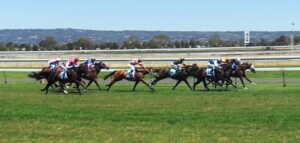 The term ‘steeplechase’ was first recorded in the late eighteenth century and was derived from the fact that participants kept a course, over open countryside and natural obstacles, by sighting a church steeple as a finishing point. Nowadays, the term refers to a horse race run on a turf course furnished with fabricated obstacles – albeit that they are constructed, in part, with natural materials – which horses must negotiate.
The term ‘steeplechase’ was first recorded in the late eighteenth century and was derived from the fact that participants kept a course, over open countryside and natural obstacles, by sighting a church steeple as a finishing point. Nowadays, the term refers to a horse race run on a turf course furnished with fabricated obstacles – albeit that they are constructed, in part, with natural materials – which horses must negotiate.
Steeplechase fences are the higher, more rigid and less forgiving type of obstacle that horses encounter in National Hunt racing. With the exception of the optional water jump, which need only be a minimum of 3′ high – but is, as the name suggests, followed by an expanse of water at least 9′ wide – steeplechase fences must officially be at least 4’6″ high, measured from the take-off side. By way of comparison, the tallest fence on the Grand National course, The Chair, measures 5’2″ high.
Steeplechase fences are essentially of two types, known as plain fences and open ditches, although the construction of the upright portion of the fence is the same in both cases. Each fence is built on a base measuring between 6′ and 6’6″ deep, from the front of the take-off board – the white-painted board at the foot of the fence, intended to increase its visibility – and consists of a rigid frame, made of steel or wood. Fence construction must be consistent throughout any one course, but the frame may be filled entirely with birch, natural or plastic, or birch and spruce or other material approved by the British Horseracing Authority (BHA). Either way, the density of the compacted material determines how forgiving the fence is if a horse makes a jumping error. As the name suggests, an open ditch is simply a plain fence with a ditch on the take-off side, thereby creating an obstacle with a significantly wider spread.
